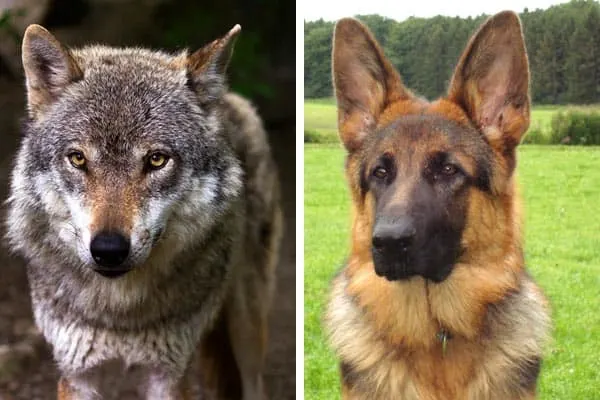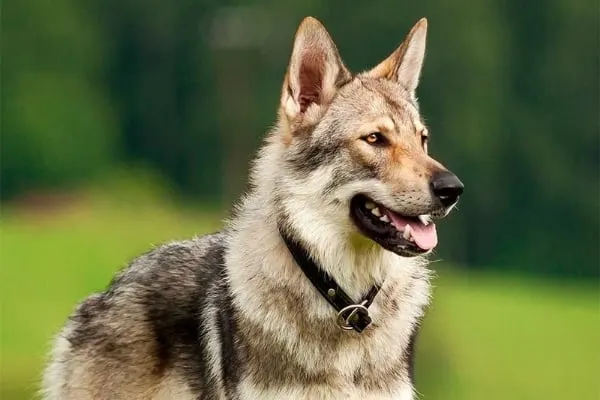Is My German Shepherd Part Wolf: Learn About Wolf-Dog Hybrids
Some dog breeds simply look more like wolves than other dog breeds.
For example, while it is easy to imagine that the German Shepherd dog breed evolved in some way from an ancient wild wolf, it is a lot less easy to visualize this when looking at a Dachshund!
But just because a dog may look a lot like a wolf isn’t necessarily proof that your GSD has modern wolf blood in them.
In this article, learn about wolf-dog hybrids and how to tell if your German Shepherd is part wolf.
Is My German Shepherd Part Wolf? The simple truth is that all domestic dogs today have wolves in their ancestry.
However, unless you have specific information or the results of a genetic test that clearly indicates your own German Shepherd dog has one wolf or wolf-hybrid parent, the chances are high that your dog is not a part wolf.

Watch a Wolf Vs a German Shepherd At Mealtime
In this YouTube video, it is a lot easier to see how a wild wolf still actually looks quite different from a domesticated German Shepherd dog – and they act quite differently in many ways as well.
The German Shepherd is larger, calmer, more attentive to his person, and has a much thicker coat than does the wild wolf.
Even though the video maker explains that the two have been raised together since puppyhood, the wild wolf is still skittish and less trusting around people – even the one person she has a long positive association with.
It is an interesting video to contemplate – how would your German Shepherd dog act or look differently if your dog did have wolf or wolf-hybrid parents?
What Is a Wolf-Dog Hybrid?
The International Wolf Center explains that a wolf-dog hybrid is basically a dog that has a modern wolf and domestic dog DNA.
The wolf, Canis lupus, and the domestic dog, Canis lupus familiaris, are still genetically quite similar even though the species lines parted ways between 20,000 and 40,000 years ago (more on this interesting event in the next section here).
One key way that wolves and dogs are still alike, however, is that they are what is called “inter-fertile.” This means a wolf can breed with a dog or vice versa.
When this happens, the puppies are called “wolf-dog hybrids.”
While wolf-dog hybrids definitely do exist and some breeders even deliberately breed for this combination, many experts feel it is not a good idea.
It is definitely challenging to provide for the needs of a wolf-dog hybrid in captivity.
These animals tend to adapt less well to the presence of people. They can become aggressive when they mature and are ready to mate.
And their digestion is often less able to tolerate the omnivorous diet of a fully domestic dog.
Wolf-dog hybrids are also not tolerant of being on their own and can become extremely destructive and aggressive if expected to stay alone for any length of time.
So while it can seem like a great idea to own and care for a wolf-dog hybrid, most people are simply not set up to provide the specialized care these inter-bred animals require to stay healthy and enriched in a captive environment.

Science Tells Us All Dogs Were Once Wolf-Dog Hybrids
This can feel especially confusing to digest at first, however, because as most people know, dogs and wolves are descended from a common wild wolf ancestor.
But as Smithsonian highlights, researchers and canine biologists continue to disagree over nearly every aspect of how and when dogs and wolves parted ways genetically.
Science Magazine even theorizes that dogs could have parted ways from the wolf genome more than once!
Scientists also don’t see eye to eye on whether dogs domesticated people or people domesticated dogs.
There is evidence both ways and it would seem we may never uncover the full truth of what happened so far in our shared past.
How Did Wolves Become Domestic Dogs?
While scientists don’t fully agree on when or where wild wolves first started diverging and becoming domesticated dogs, science does know that the parting of ways seems to have revolved around access to food resources.
Wolves are obligate carnivores, which means that their digestive tract has evolved to eat only animal protein. Dogs are omnivores like people, which means they can eat both animal protein and plant matter.
Ancient wolves that scavenged near people may have had a disposition scientists describe as “friendlier,” which likely translates to mean “more tolerant of the presence of people.”
In return, some people may have picked up on the usefulness of having wolves nearby to warn them of other approaching dangers.
And in this way, slowly but surely, a partnership of mutual advantage may have formed.
One other fact scientists seem to generally agree on is that even modern wolves come from a now-extinct species of ancient wolf.
So the wolf species that started it all did not survive, as Live Science explains. Instead, this species led to both the modern gray wolf and the modern domestic dog.

How Closely Is the German Shepherd Dog Breed Related to the Wolf?
As a canine researcher explains in Psychology Today, the modern dog breeds that are most closely related genetically to wolves tend to be the least friendly to people.
As you saw in the YouTube video clip you watched earlier, this absolutely applies when you compare the wolf’s behavior with the GSD’s behavior at mealtime.
In fact, the German Shepherd is known to be intensely people-focused and very bonded with “their” people.
These dogs have been specifically bred to work very closely with people in intense and demanding jobs.
German Shepherds don’t even make the top 10 list of the dog breeds that are related most closely to the modern wolf genome (DNA).
(In case you are curious, the modern domestic dogs that have the most “wolf DNA” in them are the Chinese Shar-Pie, the Siberian Husky, the Saluki, the Afghan Hound, the Alaskan Malamute, the Akita, the Chow Chow, the Shiba Inu, and the Basenji.)
Why Does the German Shepherd Look So Much Like a Wolf?
The German Shepherd Dog Club of America (GSDCA) shares an interesting observation about the man credited with developing the German Shepherd dog breed.
This man, Captain Max von Stephanitz, was said to have discovered a dog with a wolf-like appearance at a dog show in Germany.
He bought the dog and began breeding it with other dogs to create an entirely new dog breed.
The Captain’s ultimate goal with dog breeding was to create the ultimate perfect livestock herding dog.
But in this, his goal was always to develop working dog traits rather than to create a perfectly uniform appearance to these dogs.
He also added some additional genetically unrelated herding dog breeds to his breed line to keep the gene pool more diverse for health reasons and to keep the herding tendency and trait strong in his new dog breed.
Today, German Shepherds are bred both for show competitions (to an appearance standard) and for working dogs (to a trait standard).
These dogs both look a lot like wild wolves, but there is more appearance diversity in the working dog line to this day.
Just because German Shepherds look a lot like wolves doesn’t mean they act like wolves. Actually, these loving, people-oriented dogs are a lot less wolf-like on the inside.






























